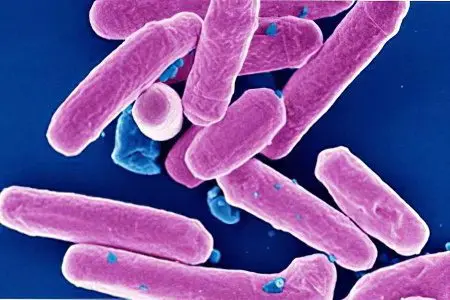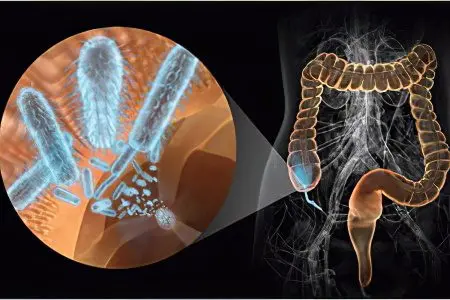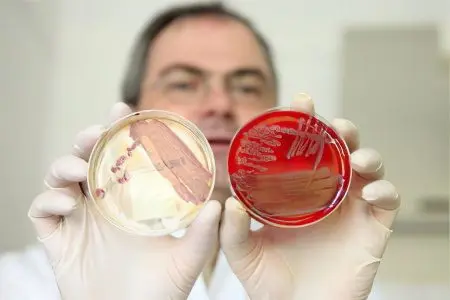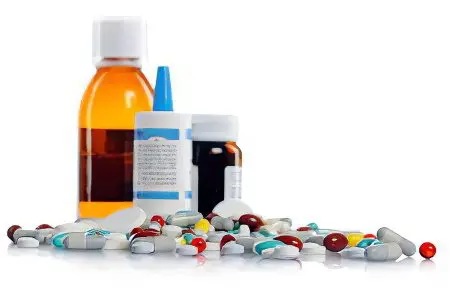Contents

Dysentery – This is an intestinal infection that can be caused by amoeba or shigella, so it is divided into shigellosis and amoebiasis. Shigella were first discovered by the Japanese Kiyoshi Shiga, and amoebas, as causative agents of dysentery, by the Russian scientist Lesh F.A.
Amoebiasis is rare in Russia, to a greater extent this disease is common in countries with a hot climate, for example, in India or Mexico. Dysentery has characteristic symptoms. It is important to know and be able to distinguish them from other manifestations of intestinal infections. This will allow you to start treatment on time.
The disease is manifested by vomiting, symptoms of general intoxication of the body, nausea, belching, heartburn, diarrhea, abdominal pain, etc. More details about the manifestations of dysentery will be discussed later.
It must be understood that it will not be possible to make a correct diagnosis only on the basis of the symptoms of the disease. You will need to conduct an examination, pass feces for bacterial culture, and blood for serological tests.
Causes of dysentery in adults and children

Dysentery is spread by people who suffer from an acute or chronic infection. Also, its distributors are bacteria carriers.
A person suffering from an acute form of dysentery will be highly contagious, especially in the first days after the onset of the first symptoms. The acute course of the disease can persist for 3 months. At this time, a person continues to release pathogenic flora into the environment.
If the patient suffers from a chronic form of the disease, then he will secrete shigella during the stage of exacerbation of the pathology. The duration of its course can be 3 months.
People who carry the infection can shed the bacteria over time. In this case, the symptoms of the disease will be blurred, or may be absent altogether.
Infection with dysentery occurs with errors in hygiene, as well as due to the consumption of foods that are contaminated with pathogenic flora.
The infection is transmitted by the fecal-oral route. It is implemented in the following ways:
On water. This is how Flexner’s dysentery spreads.
Alimentary way. Most often, dysentery of the Zone spreads in this way.
Contact household way. Grigoriev-Shiga dysentery spreads in this way.
Flies are the carriers of the disease. Bacteria can live on food (dairy products are especially dangerous in this regard), on fruits and vegetables, on dirty hands, on any household items that a sick person has used.
People are extremely susceptible to pathogens of dysentery. In this regard, their age and gender do not matter. However, young children are predominantly affected by the disease. This is due to the low formation of their personal hygiene skills. The likelihood of infection increases in people who suffer from acute and chronic pathologies of the digestive tract, as well as from intestinal dysbacteriosis.
Outbreaks of dysentery are recorded mainly in people during the warm season: in summer and autumn. During these periods, the conditions for the reproduction of pathogenic flora are especially favorable.
The microflora, which can cause the development of dysentery, can remain active for 45 days. When microbes get into dairy and some other products, they will multiply.
The first symptoms of the disease appear after the microbes reach the intestines and begin to divide there, releasing toxic substances. These toxins enter the bloodstream and poison the human body. They negatively affect the state of the liver, intestines, blood vessels, central nervous system. When the small intestine is damaged, deep ulcerative defects are formed on it.
Symptoms of dysentery

From the moment of infection until the first symptoms of the disease appear, it can take from several hours to several days. The average duration of the incubation period is 2-3 days.
Symptoms of dysentery can be distinguished as follows:
Acute onset, accompanied by intoxication of the body. The patient’s body temperature rises, the head begins to hurt. A person feels sick, appetite completely disappears, blood pressure may decrease.
The abdomen hurts in the navel. At first, the pain is weak and diffuse, but as the pathogenic flora multiplies, it takes on the character of contractions. The pain spreads to the lower abdomen, to the pubis. The left side hurts the most. As the intestines fill up, the pain intensifies.
The occurrence of false urges to empty the intestines. At the same time, going to the toilet does not end with the act of defecation. There may be pain in the rectum. They are able to disturb a person for several minutes after emptying it. The pain is pulling, radiating to the region of the sacrum.
The chair becomes more frequent. It occurs more than 10 times a day. The stools may contain blood streaks and mucus.
In 20% of cases, the disease proceeds according to the gastroenteric type. At the same time, an increase in body temperature and disorders in the work of the digestive organs occur simultaneously. The chair immediately becomes liquid. Starting from the 2nd day of illness, a person has symptoms of colitis. Since diarrhea is intense and often accompanied by vomiting, the patient develops symptoms of dehydration. He becomes lethargic and lethargic. Blood pressure decreases, the skin and mucous membranes dry up. The amount of urine decreases.
The disease may have a different course. Sometimes dysentery is easily tolerated and a person has only weakness and malaise. In other cases, the pathology requires hospitalization of the patient, as it is accompanied by the development of fever, pallor of the skin, incessant vomiting and disturbances in the functioning of the nervous system.
If the disease becomes chronic, then intoxication of the body is not observed. However, diarrhea develops, stools are green. Against the background of chronic instability of the stool, a person develops dysbacteriosis. If the patient receives timely and correct therapy, the disease does not become chronic. This happens only when there is no medical assistance.
Symptoms of dysentery in children

Unlike adults, children develop dysentery in a slightly different way. The child has a general intoxication of the body, the stomach begins to hurt, but diarrhea does not develop. Fecal masses are excreted in small quantities, while blood and mucus are always noticeable in them. The child’s health worsens, the body temperature rises, the head starts to hurt. The child refuses to eat. Colitis with blood in the stool occurs in 90% of children with dysentery. However, its manifestations are not always acute.
When the first day of illness has passed, the character of the stool changes. During bowel movements, not feces, but mucous greenish masses may be excreted. They may show blood.
If adults have false urges to empty the intestines, then the child has relaxation of the anus, increased anxiety and crying. In children under 3 years of age, the abdomen is swollen. In older children, on the contrary, it is drawn in.
The toxic form of the disease in infants does not often develop. Symptoms of body intoxication in infants are mild, since their immunity does not respond to toxins released by microbes. To a greater extent, dysentery for infants is dangerous due to dehydration. With loose stools and vomiting, babies lose a significant amount of fluid. Moreover, dehydration develops very quickly.
Watery stools and vomiting lead to weight loss, as metabolic processes in the body are disturbed. This, in turn, threatens with problems in the functioning of the cardiovascular system, intestinal paresis and other serious health consequences.
Symptoms of staphylococcal dysentery in combination with salmonella infection will be manifested by symptoms such as:
Ileocolitis.
Ileitis.
Fever.
Severe intoxication of the body.
Incessant vomiting.
Anorexia.
Bloating and offensive stools.
In a severe course of the disease, dysentery may be accompanied by convulsive seizures, fainting, cyanosis of the skin, meningitis, tachycardia, arrhythmia, a drop in blood pressure, muffled heart tones, etc.
How to distinguish dysentery from other intestinal disorders?

Dysentery can resemble other bowel diseases, so it’s important to know the main differences between them:
Salmonellosis and food poisoning. The disease begins with frequent vomiting, which is repeated several times. The pain is concentrated in the epigastric region. Spasms on the left side of the abdomen do not occur, since the large intestine is not affected by food poisoning. There are also no tenesmus. When a patient develops salmonellosis, the feces acquire a greenish tint, resembling the appearance of swamp mud.
Amebiasis. With amoebiasis, the disease does not have such pronounced symptoms as with dysentery. Body temperature may rise, but only slightly. Blood and mucus in the stools will be present, they look like raspberry jelly. When conducting an analysis in the secretions, it will be possible to detect a huge number of amoebae.
Cholera. The first symptoms of cholera are: diarrhea, profuse vomiting, a slight increase in body temperature, tenesmus. The feces are liquid, reminiscent of the appearance of rice water. Symptoms of dehydration develop quickly, which significantly worsens the course of the disease.
Typhoid fever. With this disease, spastic colitis develops, the body temperature rises to significant levels, it persists for a long time. A rash like roseola appears on the skin.
Colitis. The disease is non-infectious in nature. Occurs against the background of intoxication of the body with chemicals. In addition, colitis can be a companion of gastritis, cholecystitis, uremia, diseases of the small intestine. The exacerbation of colitis does not depend on the season, the disease is not contagious, and does not lead to pronounced changes in the organs of the digestive system.
Hemorrhoids. In a patient, blood is released from the anus, but the large intestine does not become inflamed. Blood appears only at the end of the act of defecation.
Rectal cancer. Symptoms of intoxication of the body occur only during the decay of the tumor. In the same period, blood appears, diarrhea develops. Oncopathologies do not have an acute course, they metastasize to other organs and lymph nodes.
Dysentery treatment

If the disease develops in a child under 3 years old, then he is placed in a hospital. Adult patients can be left on an outpatient basis if their health allows it.
Therapy scheme:
Furazolidone is the drug of choice in the treatment of mild dysentery. If the disease takes on a complex form, then it can be treated with broad-spectrum antibiotics: fluoroquinolones, cephalosporins, aminoglycosides.
From the first day of illness, you need to take drugs to prevent the development of dehydration: Regidron, Oralit, Glucosolan. One sachet of the selected drug is diluted in a liter of water and offered to the child every 5 minutes, 1 teaspoon. The daily dose is calculated according to the formula 110 ml x 1 kg of weight.
Eubiotics to prevent the development of intestinal dysbacteriosis. You need to take them for at least 3 weeks. These can be drugs such as: Bifidumbacterin, Bifiform, Linex, Rioflora Immuno.
The doctor may prescribe drugs to the patient to increase immunity, vitamins, antispasmodics, etc.
When the acute phase of dysentery is stopped, the use of drugs that accelerate the regeneration of the mucous membranes will be required. They do microclysters. It can be rosehip oil, sea buckthorn, Vinylin and chamomile.
To remove harmful substances from the body, medicines such as: Smecta, Polysorb, Polyphepan, Filtrum STI, etc., help.
To improve the processes of digestion of food, Festal, Creon, Mezim, Pancreatin are used.
If the disease becomes chronic, you need to send the patient to physiotherapy. He is shown taking eubiotics, setting microclysters.
During treatment, a diet is required. The patient is offered slimy soups, rice decoction, mashed potatoes, unsalted boiled cereals. If the child refuses to eat, you can not force him to eat. It is important to make sure that he drinks water. You can also offer him tea without sugar, whey. It is forbidden to eat pastries, meat dishes, coffee, semi-finished products, sausages, smoked meats, cheeses, etc. From the 5th day from the onset of the disease, it is allowed to eat kefir, meatballs, scrambled eggs, boiled fish.









